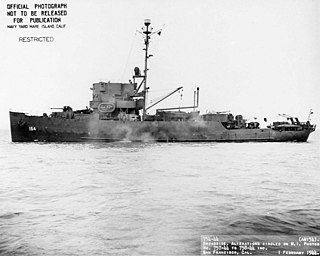
USS Admirable (AM-136) was the lead ship of her class of minesweeper built for the United States Navy during World War II. In commission from 1943 to 1945, she was transferred to the Soviet Navy in 1945 and served as T-331 until stricken in 1958.
USS Barrier (AM-150) was an Admirable-class minesweeper built for the United States Navy during World War II and in commission from 1944 to 1945. In 1945, she was transferred to the Soviet Union, serving in the Soviet Navy after that as T-335.
USS Bombard (AM-151) was an Admirable-class minesweeper built for the United States Navy during World War II and in commission from 1944 to 1945. In 1945, she was transferred to the Soviet Union, serving after that in the Soviet Navy as T-336.
USS Bond (AM-152) was an Admirable-class minesweeper built for the United States Navy during World War II and in commission from 1943 to 1945. In 1945, she was transferred to the Soviet Union and served after that in the Soviet Navy as T-285 and as BRN-37.
USS Augury (AM-149) was an Admirable-class minesweeper built for the United States Navy during World War II and in commission from 1943 to 1945. In 1945, she was transferred to the Soviet Navy, in which she served as T-334.
USS Astute (AM-148) was an Admirable-class minesweeper built for the United States Navy during World War II and in commission from 1944 to 1945. In 1945, she was transferred to the Soviet Navy, in which she served as T-333.

USS Candid (AM-154) was an Admirable-class minesweeper built for the United States Navy during World War II and in commission from 1943 to 1945. In 1945, she was transferred to the Soviet Union and served after that in the Soviet Navy as T-283.
USS Capable (AM-155) was an Admirable-class minesweeper built for the United States Navy during World War II. In 1945, she was transferred to the Soviet Union and then served in the Soviet Navy as T-339.
USS Captivate (AM-156) was an Admirable-class minesweeper built for the United States Navy during World War II and in commission from 1943 to 1945. In 1945, she was transferred to the Soviet Union and then served in the Soviet Navy as T-338.
USS Caravan (AM-157) was an Admirable-class minesweeper built for the United States Navy during World War II and in commission from 1944 to 1945. In 1945, she was transferred to the Soviet Union and after that served in the Soviet Navy as T-337.
USS Caution (AM-158) was an Admirable-class minesweeper built for the United States Navy during World War II and in commission from 1944 to 1945. In 1945, she was transferred to the Soviet Union and after that served in the Soviet Navy as T-284.

USS Disdain (AM-222) was an Admirable-class minesweeper built for the United States Navy during World War II and in commission from 1944 to 1945. She was transferred to the Soviet Union in 1945 and after that served in the Soviet Navy as T-271.
USS Fancy (AM-234) was an Admirable-class minesweeper built for the United States Navy during World War II and in commission from 1944 to 1945. In 1945, she was transferred to the Soviet Union and served in the Soviet Navy after that as T-272 and Vyuga.
USS Marvel (AM-262) was an Admirable-class minesweeper built for the United States Navy during World War II and in commission from 1944 to 1945. In 1945, she was transferred to the Soviet Union and then served in the Soviet Navy as T-272. The Soviets converted her into a naval trawler in 1948 and renamed her Passat.

USS Measure (AM-263) was an Admirable-class minesweeper built for the United States Navy during World War II and in commission from 1944 to 1945. In 1945, she was transferred to the Soviet Union and served in the Soviet Navy from 1945 to 1947 as T-275. She later became the civilian whaling ship Buran ("Blizzard").
USS Mirth (AM-265) was an Admirable-class minesweeper built for the United States Navy during World War II and in commission from 1944 to 1945. In 1945, she was transferred to the Soviet Union and served in the Soviet Navy after that as T-277. The Soviets converted her into a naval trawler in 1948 and renamed her Musson.
USS Nucleus (AM-268) was an Admirable-class minesweeper built for the United States Navy during World War II and in commission from 1943 to 1945. In 1945, she was transferred to the Soviet Union and after that served in the Soviet Navy as T-278. The Soviets converted her into a naval trawler in 1948 and renamed her Uragan.

USS Palisade (AM-270) was an Admirable-class minesweeper built for the United States Navy during World War II and in commission from 1944 to 1945. In 1945 she was transferred to the Soviet Union and served in the Soviet Navy after that as T-279.
USS Penetrate (AM-271) was an Admirable-class minesweeper built for the United States Navy during World War II and in commission from 1944 to 1945. In 1945, she was transferred to the Soviet Union and after that served in the Soviet Navy as T-280. The Soviets converted her into a naval trawler in 1948 and renamed her Taifun.
USS Peril (AM-272) was an Admirable-class minesweeper built for the United States Navy during World War II and in commission from 1944 to 1945. In 1945, she was transferred to the Soviet Union and after that served in the Soviet Navy as T-281.




